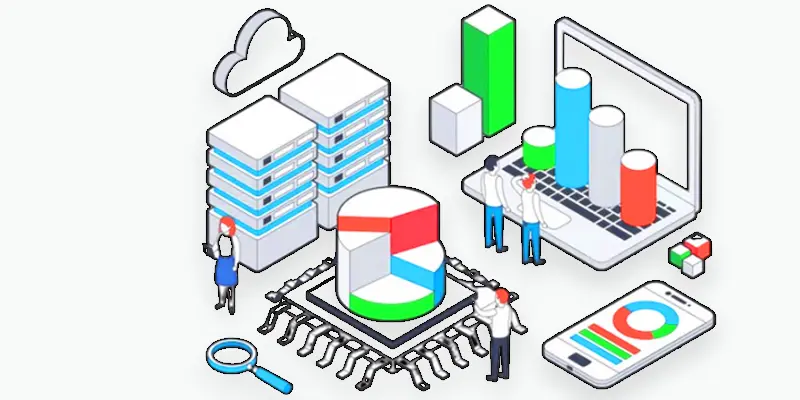What Is a DBMS? Guide with Examples and Languages
Published: 20 Sep 2024
What is a Database Management System with Example
A database management system (DBMS) is software that simplifies data management, structuring, and storage. Think of it like a digital filing cabinet where you can keep all your information safe and well-organized, so you can quickly find and use it when needed. Instead of having piles of papers or files scattered everywhere, a DBMS helps keep everything in one place, making it simple to add, update, or retrieve data whenever you need it.
Popular Database Management System Examples Used Today
- MySQL: Popular for websites and applications.
- Microsoft SQL Server: Used in many businesses for managing data.
- Oracle Database: Known for handling large amounts of data.
- PostgreSQL: Open-source and supports advanced features.
- SQLite: Lightweight and used in mobile apps and small projects.
Main Functions of Database Management System
- Stores data: It keeps all your information in one place, like a digital storage space.
- Organizes data: It arranges the data neatly, so it’s easy to find and use.
- Manages data: It helps add, update, or delete information whenever needed.
- Ensures data security: It protects your data from unauthorized access or loss.
- Allows multiple users: It lets different people access and work with the data at the same time.
- Provides easy access: You can quickly search for and retrieve specific information with just a few clicks.
Important Features of Database Management System

How Data is Stored and Organized in DBMS
Data Storage and Organization in a DBMS mean keeping information neat and structured, like putting files in labeled folders. This makes it easy to find, update, or manage the data whenever needed. Everything is stored in one place, so accessing and working with it is simple.
How DBMS Ensures Data Security and Privacy
Data Security in a DBMS means protecting your information from unauthorized access or changes. It ensures that only people with permission can view or modify the data, keeping it safe from hackers or accidental mistakes. This helps keep sensitive information secure.
Database Backup and Recovery Techniques in DBMS
In a database management system, data backup and recovery involve creating frequent copies of data to guard against loss. You can use these backup copies to restore your data if something goes wrong, like a computer crash or accidental deletion. This helps ensure you don’t lose important information.
How DBMS Handles Multiple User Access without Conflict
Multiple User Access in a DBMS means that several people can use and work with the database at the same time without causing problems. It allows different users to view, add, or update data simultaneously, making teamwork and collaboration easier.
How DBMS Maintains Data Consistency During Transactions
Data Consistency in a DBMS ensures that all information remains accurate and up-to-date, even when multiple people are working with it. It prevents errors or conflicting changes, so everyone sees the same reliable data. This helps keep everything correct and reliable.
Evolution of Database Management Systems Over Time
The history of Database Management Systems (DBMS) started in the 1960s and has evolved over time:
How DBMS Evolved from 1950s to Modern Cloud Databases
In the 1950s and 60s, databases were basic and mainly used in big computers to manage simple data. They were often just files or simple structures, making it hard to organize and retrieve information efficiently. This was the beginning of how we started handling data in computers.
1970s
In the 1970s, Edgar Codd introduced the relational database model, which was a major improvement over earlier systems and became widely used. This new approach organized data into tables with rows and columns, making managing and retrieving information much easier.
1980s
Commercial Database Management Systems (DBMSs), such as IBM’s DB2 and Oracle, were developed in the 1980s. These systems brought more features and made databases more useful for businesses. They helped companies manage their data more effectively and made databases more accessible.
1990s
In the 1990s, the rise of the internet brought about new types of databases, particularly web-based DBMSs. These systems were designed to support online applications and e-commerce, allowing businesses to handle growing amounts of data through websites. This era marked a shift towards more dynamic, internet-driven database management.
2000s-Present
Since the 2000s, Database Management Systems have evolved to handle large amounts of data and support new technologies like cloud computing. They now manage everything from social media data to real-time analytics, making storing and analyzing vast volumes of information easier. This period has seen rapid advancements, making databases more powerful and versatile.
Types of Database Languages in DBMS
Database languages are special types of computer languages used to create, manage, and interact with databases. They help users and software programs add, update, retrieve, and organize data in a database. There are five main types of database languages:
What is SQL in DBMS with Example
Databases can be contacted using SQL (Structured Query Language). This language allows you to ask questions, search for specific information, and make changes to the data, like adding, updating, or deleting records. Think of it as a tool that helps you easily interact with and manage your data.
What is DDL in SQL With Simple Explanation
Data manipulation language, or DML for short, is a feature of SQL that allows data manipulation inside databases. It helps you set up tables, define their columns, and change or remove these structures as needed. Essentially, DDL lets you design and organize how your data is stored in the database.

What is DML in SQL with Example Queries
DDL, a component of SQL, is used to design and maintain a database’s structure. DML lets you add new information, update existing data, or delete records. It is like the tool you use to manage and adjust the actual content in your database tables.
Commands of DCL in SQL with Uses
It is a part of SQL that manages who can access or modify the data in a database. It allows you to grant or revoke permissions for different users, making sure only authorized people can see or change certain information. DCL helps control and protect your database’s security.
Examples of Procedural Languages Used in DBMS
Procedural languages are used to write detailed scripts and procedures for complex database tasks. They let you automate repetitive tasks and create custom functions, such as PL/SQL for Oracle or T-SQL for SQL Server. Think of them as a way to program specific actions and logic that go beyond basic data management.
DBMS Use Cases
- Managing Customer Information: Businesses use a DBMS to store and organize customer details, such as names, contact information, and purchase history. This helps them keep track of customers, personalize services, and improve marketing efforts.
- Handling Inventory: A DBMS helps businesses keep track of their products or stock levels. It makes it easy to update inventory records, check availability, and manage orders, ensuring they have the right products in stock.
- Storing and Analyzing Data: Organizations use a DBMS to collect and analyze large amounts of data for insights. This can include sales data, performance metrics, or user activity, helping businesses make informed decisions and improve their operations.
Difference Between File System and DBMS with Example
- Better Organization: Data is stored in neat tables with rows and columns, making it easier to find and manage.
- Efficiency: It’s quicker to search, update, and retrieve information than to deal with scattered files.
- Consistency: A DBMS keeps data accurate and consistent, even when multiple people are using it at once.
- Security: It provides better protection for your data, with access controls and regular backups.
- Scalability: Unlike a basic file system, a DBMS can handle large amounts of data and grow with your needs.
How have DBMSes changed in terms of how they are built, sold, and serviced?
- Building: Modern DBMSes involve using advanced technologies and cloud services to create more powerful and flexible systems. They can be tailored to meet specific demands and are built to handle massive volumes of data effectively. This approach allows for better performance and easier scaling as data needs grow.
- Selling: Today, DBMSes are often sold as cloud-based services, which means businesses can access and use them over the Internet. Businesses can avoid purchasing and maintaining pricey gear and software in this way. Rather, customers pay for what they use, lowering costs and increasing convenience.
- Servicing: Modern DBMSes have become easier with online support and regular updates. Companies offer help through websites, forums, and customer service teams to quickly fix issues and answer questions. This makes it simpler to keep the system running smoothly and up-to-date.
Best Practices to Optimize Database Performance in DBMS
Optimizing database performance means making sure your database runs as fast and efficiently as possible. This involves:

- Speeding up Queries: Speeding up queries means making sure the database finds and shows the information you need as quickly as possible. This involves optimizing how the database searches through data, using indexes to speed up lookups, and making sure unnecessary processes don’t slow the system down. The goal is to get the results you want fast, without delays.
- Reducing Load: Reducing load means making sure the database can handle a lot of users or data without slowing down. This involves managing the amount of work the database has to do at once so it doesn’t get overwhelmed. Balancing the workload and optimizing data processing keeps everything running smoothly, even during busy times.
- Managing Resources: Managing resources means efficiently using the database’s memory and processing power. This involves ensuring that the database doesn’t use more resources than necessary and that it’s balanced to handle tasks effectively. Proper resource management helps prevent slowdowns and ensures the database operates smoothly.
How DBMS Works on IBM z/OS Systems
- z/OS Overview: z/OS is an operating system for IBM mainframe computers. It is known for handling large-scale data and critical business applications.
- DB2 for z/OS: A popular DBMS designed for z/OS that manages large volumes of data efficiently and securely.
- Performance: DB2 is optimized for high performance, allowing fast data processing and quick access even under heavy loads.
- Reliability: DB2 on z/OS offers strong reliability and uptime, which is crucial for businesses needing constant data access.
- Integration: It integrates well with other IBM software and systems, making it a powerful choice for enterprise environments.
Conclusion About Why Database Management System is Important Today
Effective data management and storage require a database management system (DBMS). A DBMS helps keep data secure, consistent, and easily accessible, whether you’re handling customer information, inventory, or large volumes of data. By using a DBMS, businesses can ensure their data is organized, protected, and efficiently managed, making it easier to make informed decisions and run operations smoothly.
FAQS – What’s DBMS
DBMS software helps manage, organize, and store data within a computer system. It makes handling large amounts of information more manageable by keeping it organized and accessible.
A database management system is software that helps with computer data administration. It allows you to store information in a structured way so you can quickly find and work with it.
It’s a program that helps you store, organize, and manage data on a computer. It makes it easy to keep track of information and perform tasks like searching, updating, or deleting records.
A DBMS (Database Management System) is software used to store, manage, and organize data. For example, MySQL is a popular DBMS that stores data for websites and apps.
A database management system is a tool that helps users create, manage, and access data easily. It keeps data organized and safe from loss or duplication.
DBMS is software that handles data storage and access. Its main functions are data storage, retrieval, updating, and user access control.
A DMS (Document Management System) is used to store and manage digital documents. It helps in organizing, sharing, and securing files in one place.
Google Drive is a common example of a Document Management System. It allows you to upload, store, and share documents online.
A DMS scans, stores, and organizes documents in digital form. Users can search, access, and manage documents easily from any device.
In a database, DMS may refer to how documents or records are stored and managed digitally.
It works alongside DBMS to handle unstructured document data.
DMS in Excel might refer to using Excel as a simple Document Management tool. It can store document info like file names, locations, or tracking logs.

- Be Respectful
- Stay Relevant
- Stay Positive
- True Feedback
- Encourage Discussion
- Avoid Spamming
- No Fake News
- Don't Copy-Paste
- No Personal Attacks

- Be Respectful
- Stay Relevant
- Stay Positive
- True Feedback
- Encourage Discussion
- Avoid Spamming
- No Fake News
- Don't Copy-Paste
- No Personal Attacks





